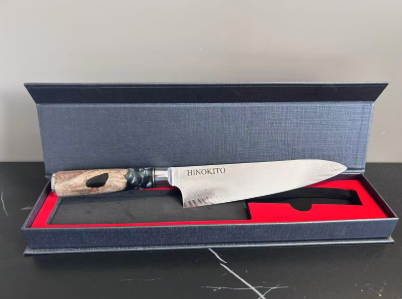In any kitchen, whether it’s a bustling professional space or a cozy UK home kitchen, there are unwritten rules. Among the most sacred is this: you don’t touch another person’s knives without permission. To an outsider, this might seem overly precious. It’s just a tool, right? But for anyone who takes their cooking seriously, from a seasoned chef to a passionate UK home cook, a knife is far more than that. It’s a personal, fine-tuned extension of their hand.
This unspoken rule isn’t just about professional pride; it’s rooted in practical concerns involving hygiene, safety, and the meticulous care a quality blade requires. The bond between a cook and their knife set is personal. Using someone else’s blade is like borrowing a stranger’s toothbrush—it’s a breach of personal space and custom. This article will explore the deep-seated reasons behind this kitchen etiquette, helping you understand why respecting a chef’s kitchen knives is so important.
Hygiene and Safety First
The most immediate reasons for not sharing kitchen knives are hygiene and safety. Every kitchen carries the risk of cross-contamination, and sharing tools without proper sanitization significantly increases that risk.
The Risk of Cross-Contamination
When you’re in your own kitchen, you have a system. You know which board you used for raw chicken and which knife you used to chop it. You clean your tools to your own standards. When someone else grabs your knife, that control is lost. They might unknowingly use a knife meant for vegetables to slice raw meat, or fail to clean it properly afterward. This can easily spread harmful bacteria like Salmonella or E. coli, posing a health risk to everyone. In a professional kitchen, this is a critical health code violation. For the dedicated home cook, it’s a matter of keeping family and friends safe.
Accidents with Unfamiliar Tools
Safety is also a major concern. A knife that feels perfectly balanced and comfortable in one person’s hand can feel awkward and unwieldy in another’s. The weight, handle shape, and blade length are all factors a cook gets used to. When you pick up an unfamiliar knife, you lose that muscle memory. This disruption can easily lead to a slip, resulting in a nasty cut. A blade that is sharper—or duller—than you expect can also cause accidents. A sharp knife requires a respectful, light touch, while a dull one requires more force, increasing the chance of it slipping.
A Matter of Maintenance and Respect
A high-quality knife, especially a specialized tool like a Japanese knife, is an investment. Proper care is essential to protect that investment and ensure the blade performs at its best for years to come.
The Art of Knife Care
Every cook has their own ritual for knife care. Some wipe their blade clean immediately after each use, while others might let it sit for a moment. Some hand-wash and dry their knives meticulously, while others might be tempted to toss them in the dishwasher—a cardinal sin for any quality blade, as the harsh detergents and high heat can damage the steel and handle.
Using a knife on an improper surface, like a glass or granite countertop, can instantly dull or chip the edge. Someone unfamiliar with the owner’s standards might unknowingly abuse the knife, causing damage that is difficult and expensive to repair. For owners of premium blades, like Sakuto knives, which are known for their precision and craftsmanship, this kind of mistreatment is heartbreaking.
The Precision Edge
The sharpness of a knife is its most important feature, and maintaining that edge is a personal craft. Cooks spend time and money learning to sharpen their knives to a specific angle that suits their cutting style. Some prefer a razor-sharp, delicate edge for fine slicing, while others might maintain a more robust edge for heavy-duty chopping.
When someone else uses your knife, they can alter that carefully honed edge. They might apply too much pressure or use it for a task it wasn’t designed for, like trying to cut through bone with a delicate slicing knife. This can misalign, chip, or dull the blade, undoing hours of sharpening work. Restoring that perfect edge requires time and skill, and it’s a frustration any serious cook would rather avoid.
Personal Preference and Workflow
Beyond the practical concerns, the connection between a cook and their knife is deeply personal. It’s about comfort, efficiency, and the seamless flow of work in the kitchen.
A cook’s preferred knife feels like a natural part of their body. They know its weight, its balance point, and how the handle fits in their palm. This familiarity allows for a fluid, efficient workflow. They can chop, slice, and dice with speed and precision without a second thought.
Using someone else’s knife disrupts this rhythm. A handle might be too small, a blade too heavy, or the balance point all wrong. This forces the user to adjust their grip and technique, slowing them down and making the task feel clumsy. In the fast-paced environment of a professional kitchen, this loss of efficiency is a serious problem. For the home cook, it simply takes the joy out of preparing a meal. A great kitchen knife set is chosen to fit the owner’s hand and cooking style, and that personal fit is impossible to replicate.
Cultural and Professional Etiquette
In the world of professional chefs, the rule of not touching another’s knives is deeply ingrained. A chef’s knife roll is their personal toolkit, built up over years of experience. It represents their craft, their dedication, and their personal style. Asking to borrow a knife can be seen as unprofessional and disrespectful. It suggests you came to work unprepared.
This tradition has its roots in the historical apprenticeship system, where a young chef’s first major purchase was their own set of knives. Owning and maintaining these tools was a rite of passage, a symbol of their commitment to the culinary arts. This culture of respect for one’s tools has carried over to the modern kitchen. Even in a shared home kitchen, observing this boundary shows respect for the owner’s property and their passion for cooking.
Finding a Solution in a Shared Space
So, what can you do in a shared kitchen? The answer is simple: communication and ownership.
- Communicate:If you need to use a knife, always ask first. Explain what you need it for and be prepared to be told no. Respecting their decision is key.
- Invest in Your Own Knives:The best solution is to own your own knives. You don’t need a massive collection to start. A good chef’s knife, a paring knife, and a serrated bread knife form a solid foundation for any UK kitchen. As your skills grow, you can add to your collection.
- Create Designated Knives:In a shared living situation, it can be helpful to have a communal, inexpensive knife set for general use. This protects everyone’s personal, high-quality knives from accidental misuse.
Build Your Own Culinary Toolkit
The unspoken rule of not using another person’s knives is about much more than simple possessiveness. It’s a practice built on respect for safety, hygiene, and the personal connection a cook has with their most essential tools. A knife is a precision instrument, lovingly cared for and customized to its owner’s hand and habits.
Instead of reaching for someone else’s blade, consider it an opportunity to start building your own trusted culinary toolkit. Investing in a quality kitchen knife set, like a versatile collection of Japanese knives UK home cooks love, will not only make you a better cook but also give you a deeper appreciation for the craft. Take the time to learn proper knife care, and you’ll develop the same bond with your blades that makes chefs so protective of theirs.





